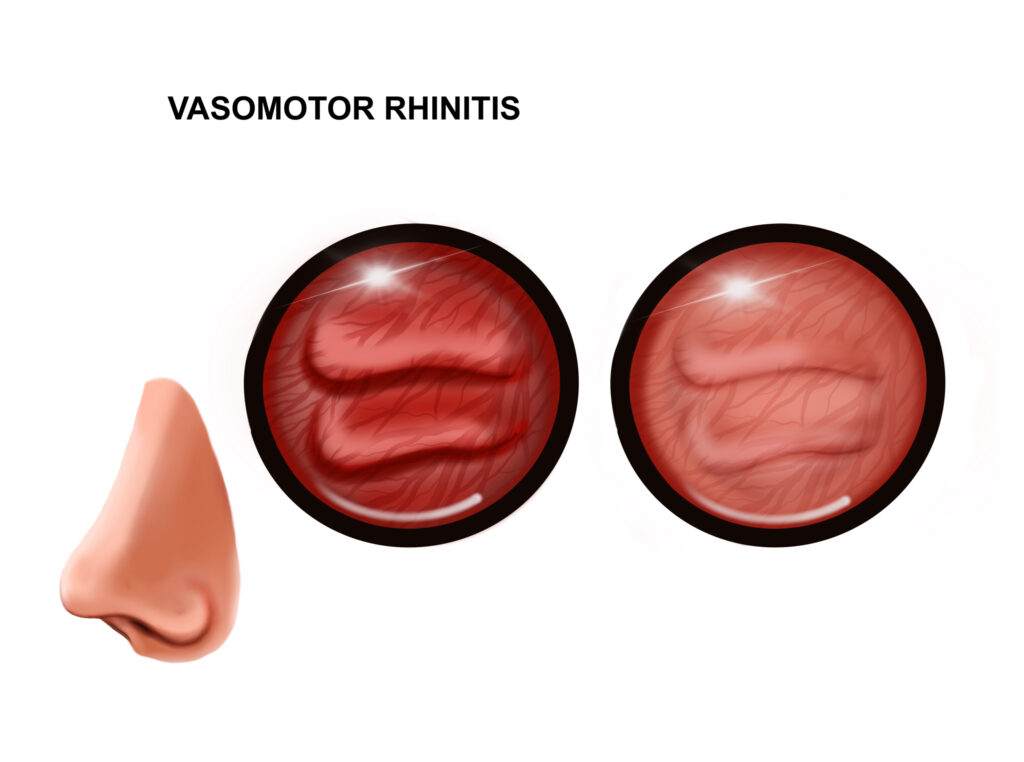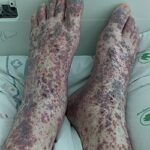Vasomotor rhinitis is a chronic, nonallergic condition characterized by nasal congestion, runny nose, sneezing, and postnasal drip without an identifiable allergic cause. Unlike allergic rhinitis, which is triggered by allergens such as pollen or dust mites, vasomotor rhinitis arises due to imbalances in the autonomic nervous system that affect blood vessels in the nasal mucosa.

Key Features of Vasomotor Rhinitis
- Nonallergic origin: Not caused by allergens or infections
- Chronic symptoms: Often persistent and not seasonal
- Triggers: Weather changes, strong odors, pollution, stress
- Demographics: More common in adults over 20 years of age
Pathophysiology: What Happens in Vasomotor Rhinitis
The underlying mechanism involves dysregulation of the autonomic nervous system, particularly the parasympathetic and sympathetic responses within the nasal mucosa. This dysregulation leads to abnormal vasodilation or vasoconstriction, causing symptoms like nasal obstruction and rhinorrhea.
Common Triggers and Aggravating Factors
Environmental Stimuli
- Sudden temperature or humidity changes
- Strong perfumes or chemical fumes
- Tobacco smoke and air pollution
Physical and Emotional Factors
- Stress and anxiety
- Hormonal changes (e.g., during pregnancy)
- Use of certain medications (e.g., beta-blockers, NSAIDs)
Clinical Presentation: Signs and Symptoms
Vasomotor rhinitis symptoms can mimic other forms of rhinitis but without allergic markers. Symptoms often fluctuate and may vary in intensity depending on trigger exposure.
Core Symptoms
- Nasal congestion: Persistent or intermittent
- Rhinorrhea: Clear, watery nasal discharge
- Postnasal drip: Sensation of mucus in the throat
- Sneezing: Usually not as intense as in allergic rhinitis
- Nasal itch or pressure: Occasionally present
Differential Diagnosis: Distinguishing from Similar Conditions
Proper diagnosis requires exclusion of allergic and infectious causes. A comprehensive history, physical examination, and appropriate testing are essential.
| Condition | Allergic Rhinitis | Vasomotor Rhinitis |
|---|---|---|
| Onset | Seasonal or perennial | Year-round, non-seasonal |
| Trigger | Allergens | Non-specific irritants |
| Itching & watery eyes | Common | Rare |
| Skin or blood allergy tests | Positive | Negative |
| Nasal eosinophils | Elevated | Normal or low |
Diagnostic Approach
Patient History
A thorough history focusing on symptom pattern, duration, and triggers is crucial. Identification of nonallergic factors helps distinguish the diagnosis.
Physical Examination
- Nasal endoscopy may show boggy, pale nasal turbinates without signs of inflammation.
- Absence of purulent discharge or facial pain (common in infectious sinusitis).
Additional Tests
- Allergy testing: To exclude allergic rhinitis
- CT scan: If sinus disease or anatomical anomalies are suspected
- Nasal cytology: May reveal a lack of inflammatory cells
Treatment Options for Vasomotor Rhinitis
Management focuses on symptom control and trigger avoidance.
Environmental and Behavioral Measures
- Identify and minimize exposure to known irritants
- Use of humidifiers to maintain moist indoor air
- Regular nasal saline irrigation
Pharmacologic Treatments
| Class | Medications | Purpose |
|---|---|---|
| Intranasal Anticholinergics | Ipratropium bromide | Reduces nasal secretions |
| Intranasal Corticosteroids | Fluticasone, Budesonide | Reduces inflammation and swelling |
| Antihistamines | Azelastine (topical) | Limited role, but can relieve some symptoms |
| Decongestants | Oxymetazoline (short-term) | Reduces nasal congestion |
Long-term use of topical decongestants should be avoided due to the risk of rhinitis medicamentosa (rebound congestion).
Advanced and Alternative Therapies
Surgical Options
Reserved for refractory cases with structural abnormalities such as deviated septum or enlarged turbinates. Procedures may include:
- Septoplasty
- Turbinate reduction
- Endoscopic sinus surgery
Complementary Therapies
- Acupuncture
- Capsaicin nasal spray (desensitizes nasal mucosa)
- Cognitive-behavioral therapy for stress-related triggers
Prognosis and Long-Term Management
Vasomotor rhinitis is a chronic condition, but with consistent management, most patients experience substantial relief. Multimodal approaches combining lifestyle adjustments and pharmacologic treatments are the most effective.
Frequently Asked Questions:
What is the main cause of vasomotor rhinitis?
Vasomotor rhinitis results from abnormal nerve reflexes in the nasal passages, leading to vasodilation and excessive mucus production in response to nonallergic stimuli.
How can vasomotor rhinitis be differentiated from allergic rhinitis?
Allergic rhinitis is triggered by allergens and confirmed by positive allergy tests, whereas vasomotor rhinitis involves non-specific irritants and has negative allergy testing.
Is vasomotor rhinitis curable?
While not curable, symptoms can be well controlled with medication, trigger avoidance, and in some cases, surgical intervention.
Can stress worsen vasomotor rhinitis?
Yes, emotional stress is a common trigger that can exacerbate symptoms due to its effect on autonomic nerve responses.
Is vasomotor rhinitis common?
Yes, especially among adults. It is often underdiagnosed because its symptoms overlap with other types of rhinitis.
Vasomotor rhinitis is a complex yet manageable condition. With proper diagnosis, tailored treatment, and awareness of individual triggers, patients can achieve significant symptom relief and improved quality of life. As we continue to refine therapeutic approaches, the importance of distinguishing this condition from allergic and infectious rhinitis remains paramount in delivering effective care.

